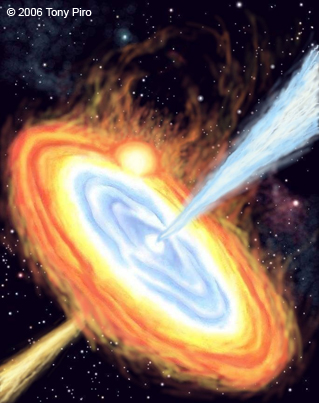|
Fragmentation of Collapsar Disks
Currently a very exciting area of research is gamma-ray bursts. These are cosmic explosions that last from less than a second to many minutes, with luminosities one million trillion times as bright as our sun. Recently it has been discovered that at least one class of these explosions is due to collapse of massive stars, most likely powered by an accretion disk that forms in their interior (these are the so-called "collapsars"). Gamma-ray bursts show variability in many different wavelengths on many different time scales. One especially interesting recent result is the discovery of X-ray flaring hundreds to hundreds of thousands of seconds after the initial flare. One theoretical interpretation is that this is due to self-gravitating instabilities in the disk, which would make these flares an important probe of the disk physics (Perna et al. 2006). In our study we consider the gravitational instabilities of these disks in further detail. We show that the instability may lead to fragmentation near the radius at which helium is photodisintegrated. These fragments will fall into the central black hole too quickly to explain the X-ray flaring, but during their infall they would be copious producers of gravitational waves. Since both viscous processes and gravitional wave emission combine to determine the angular momentum loss during infall, an unique gravitational wave signal is expected, which we calculate. As for the next step in this research, I am currently working with Vuk Mandic and Eric Thrane (U. Minnesota) to produce gravitational wave waveforms can be injected into future LIGO runs. "Fragmentation of Collapsar Disks and the Production of Gravitational Waves," A. L. Piro & E. Pfahl, 2006, Ap. J., 658, 1173 |
